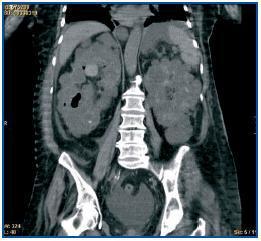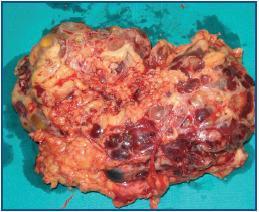Dear Editor,
Adult polycystic kidney disease (PCKD) is an inherited disorder characterised by the presence of kidney cysts, which affects approximately one in every 500 to 1,000 people. The most common manifestations are lumbar pain, haematuria and recurrent urinary infections.1,2 Emphysematous pyelonephritis is a severe infection characterised by the presence of gas in the kidney parenchyma, collecting system or perinephric tissue, and occurs primarily in diabetic patients.3
We report the case of a 76 year-old woman with hypertension, diabetes, chronic kidney disease secondary to polycystic hepatokidney disease in a peritoneal dialysis programme since March 2008, when she was admitted for fever, dysuria and haematuria. Laboratory tests showed elevated inflammatory parameters and the presence of E. coli from urine and blood culture tests. A CT scan showed a cyst on the upper right kidney complicated with air in the calices and bladder without prior manipulation of the urinary tract (Figure 1). Broad-spectrum antibiotic treatment with meropenem and gentamicin, according to the antibiogram sensitivity, was started and the patient was temporarily transferred to haemodialysis to treat intercurrent septic profile better. Despite this treatment, the patient continued to be febrile and showed a deterioration in her general condition. A new tomographic control was therefore done and a deterioration of the right kidney cyst was seen. Given the poor outcome of the septic profile with a lack of response to treatment, a right radical nephrectomy was performed, which revealed multiple kidney cysts filled with pus (Fig. 2). Further evolution was slow towards the improvement of her general condition, with a practical resolution of fever and progressive normalisation of the inflammatory parameters. Finally, the patient was able to be released after a long period of convalescence in a clinical and haemodynamically stable state, continuing kidney replacement therapy with regular haemodialysis.
In PCKD, recurrent urinary tract infections can cause septic conditions which are difficult to control due to secondary infection of the cysts. The prevalence of cystic infection is high (30-50%), and is more common in women with a history of urinary tract manipulation, nephrolithiasis and/or vesicoureteral reflux. The quinolones, trimethoprim/sulfamethoxazole and chloramphenicol reach good therapeutic concentrations within the cyst. A good response to antibiotic treatment is observed in most cases, and it is rarely necessary to take aggressive interventionist measures such as percutaneous drainage, and much less frequently, nephrectomy.
Emphysematous pyelonephritis is a severe kidney infection, usually caused by gas-producing coliform bacteria, with E. coli the most common organism, usually affecting patients with diabetes. It is characterised by its aggressive progression and poor response to treatment. It is associated with a high mortality, so nephrectomy may be advisable in selected cases.
A better understanding of the disease, the vast antimicrobial arsenal available today, with greater synergy and antibiotic potency, the emergence of minimally invasive interventional radiologic techniques and the fact that nephrectomy has a significant rate of morbidity and mortality (12 and 5%, respectively) in high-risk surgical patients, are among the factors to be considered for nephrectomy in patients with terminal kidney disease.3-5 At present, radical or partial nephrectomy should be considered for patients with a poor response to antibiotic treatment or percutaneous drainage due to its potential complications.
To summarise, the above is an example of a patient with emphysematous pyelonephritis and hepatokidney polycystosis with, firstly, a slow evolution of an unusual and severe kidney infection and, secondly, the need for radical nephrectomy as definitive treatment.
Figure 1.
Figure 2.









